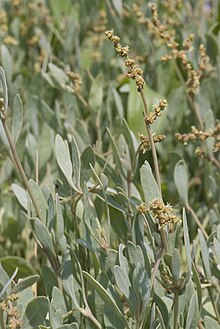
Amaranthaceae is a family of flowering plants commonly known as the amaranth family, in reference to its type genus Amaranthus. It includes the former goosefoot family Chenopodiaceae and contains about 165 genera and 2,040 species, making it the most species-rich lineage within its parent order, Caryophyllales.

The Salicornioideae are a subfamily of the flowering plant family Amaranthaceae. Important characters are succulent, often articulated stems, strongly reduced leaves, and flowers aggregated in thick, dense spike-shaped thyrses. These halophytic plants are distributed worldwide. Many are edible

The Chenopodioideae are a subfamily of the flowering plant family Amaranthaceae in the APG III system, which is largely based on molecular phylogeny, but were included – together with other subfamilies – in the family Chenopodiaceae, or goosefoot family, in the Cronquist system.

Atriplex is a plant genus of about 250 species, known by the common names of saltbush and orache. It belongs to the subfamily Chenopodioideae of the family Amaranthaceae s.l.. The genus is quite variable and widely distributed. It includes many desert and seashore plants and halophytes, as well as plants of moist environments. The generic name originated in Latin and was applied by Pliny the Elder to the edible oraches. The name saltbush derives from the fact that the plants retain salt in their leaves; they are able to grow in areas affected by soil salination.

Halimione portulacoides, commonly known as sea purslane, is a shrub found in Eurasia.

Atriplex cinerea, commonly known as grey saltbush, coast saltbush, barilla or truganini, is a plant species in the family Amaranthaceae. It occurs in sheltered coastal areas and around salt lakes in the Australian states of Western Australia, South Australia, Tasmania, Victoria and New South Wales.

Grayia is a genus of plants in the subfamily Chenopodioideae of the family Amaranthaceae. Common names are siltbush and hopsage. The four shrubby species occur in arid and semiarid regions of western North America:
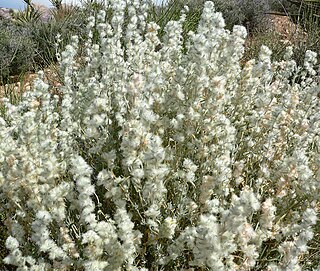
Krascheninnikovia is a genus of flowering plants in the subfamily Chenopodioideae of the family Amaranthaceae known as winterfat, so-called because it is a nutritious livestock forage. They are known from Eurasia and western North America. These are hairy perennials or small shrubs which may be monoecious or dioecious. They bear spike inflorescences of woolly flowers.
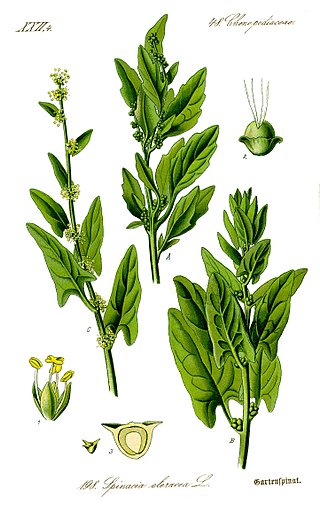
Spinacia is a flowering plant genus in the subfamily Chenopodioideae of the family Amaranthaceae. The most common member is spinach.

The Betoideae are a small subfamily of the flowering plant amaranth family, Amaranthaceae sensu lato. Commonly known members include beet, sugar beet, chard, and mangelwurzel, which all are cultivars of Beta vulgaris.

The Polycnemoideae are a small subfamily of plants in the family Amaranthaceae, representing a basal evolutionary lineage. The few relictual species are distributed in Eurasia and North Africa, North America, and Australia.

Dysphania is a plant genus in the family Amaranthaceae, distributed worldwide from the tropics and subtropics to warm-temperate regions.
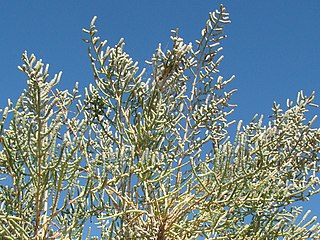
Halostachys is a genus of flowering plants in the plant family Amaranthaceae, containing a single species, Halostachys caspica. The plants are small to medium halophytic shrubs with apparently jointed fleshy stems and scale-like leaves. They are native to Asia and southeastern Europe.

Kalidium is a genus of flowering plants in the plant family Amaranthaceae. The species are shrubby halophytes distributed in Southeast Europe, Southwest Asia and Central Asia to China.
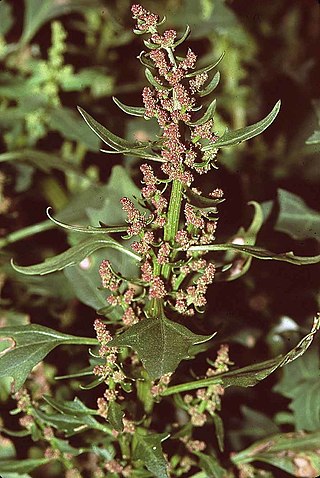
Oxybasis is a flowering plant genus from the subfamily Chenopodioideae of the family Amaranthaceae. It was first described in 1841, and newly used since 2012 for five species that were traditionally grouped into genus Chenopodium. They occur in Europe, Asia, North Africa and America.
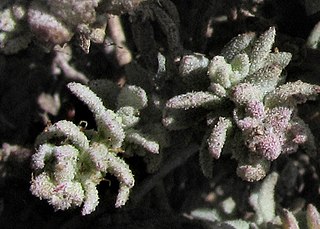
Extriplex is a plant genus in the subfamily Chenopodioideae of the family Amaranthaceae. It has been described in 2010 and comprises two species, that were formerly included in genus Atriplex. They are restricted to the California Floristic Province.

Stutzia is a plant genus in the subfamily Chenopodioideae of the family Amaranthaceae. It was described in 2010, replacing the illegitimate name Endolepis. It comprises two species, that have also been included in the genus Atriplex.

Proatriplex is a monotypic plant genus in the subfamily Chenopodioideae of the family Amaranthaceae, with the only species Proatriplex pleiantha. It is known by the common names four-corners orach and Mancos shadscale. It occurs in the Navajo Basin of Arizona, Colorado, New Mexico, and Utah.
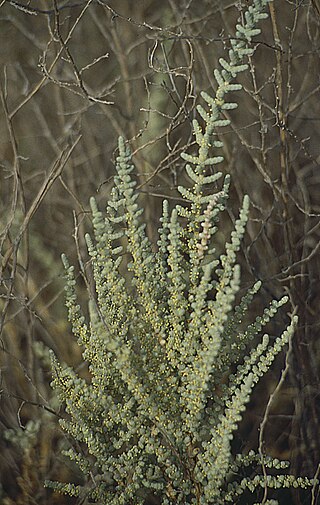
Halocnemum is a genus of halophytic shrubs in the family Amaranthaceae. The plants are fleshy and apparently articulated with characteristic globular or short-cylindrical lateral branches, and reduced leaves and flowers. There are two species, occurring from Southern Europe and North Africa to Asia.

Exomis is a genus of flowering plants belonging to the family Amaranthaceae. It just contains one species, Exomis microphylla(Thunb.) Aellen It is also in the Chenopodioideae subfamily.
